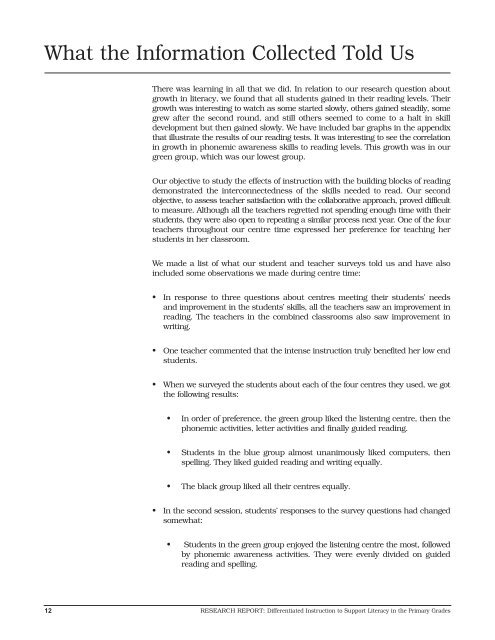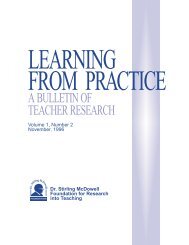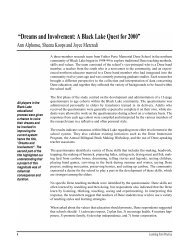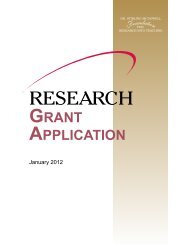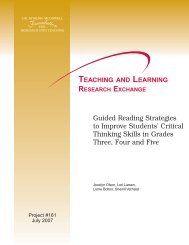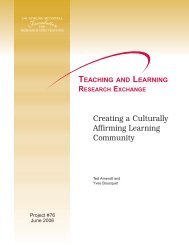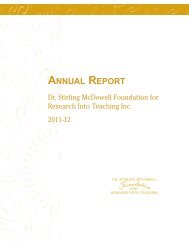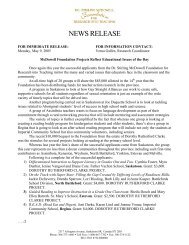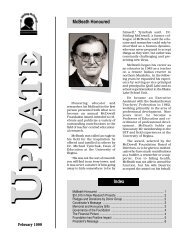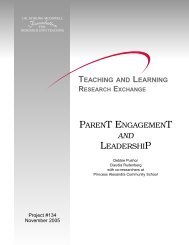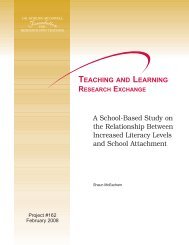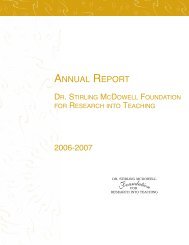Differentiated Instruction to Support Literacy in the Primary Grades
Differentiated Instruction to Support Literacy in the Primary Grades
Differentiated Instruction to Support Literacy in the Primary Grades
Create successful ePaper yourself
Turn your PDF publications into a flip-book with our unique Google optimized e-Paper software.
What <strong>the</strong> Information Collected Told Us<br />
There was learn<strong>in</strong>g <strong>in</strong> all that we did. In relation <strong>to</strong> our research question about<br />
growth <strong>in</strong> literacy, we found that all students ga<strong>in</strong>ed <strong>in</strong> <strong>the</strong>ir read<strong>in</strong>g levels. Their<br />
growth was <strong>in</strong>terest<strong>in</strong>g <strong>to</strong> watch as some started slowly, o<strong>the</strong>rs ga<strong>in</strong>ed steadily, some<br />
grew after <strong>the</strong> second round, and still o<strong>the</strong>rs seemed <strong>to</strong> come <strong>to</strong> a halt <strong>in</strong> skill<br />
development but <strong>the</strong>n ga<strong>in</strong>ed slowly. We have <strong>in</strong>cluded bar graphs <strong>in</strong> <strong>the</strong> appendix<br />
that illustrate <strong>the</strong> results of our read<strong>in</strong>g tests. It was <strong>in</strong>terest<strong>in</strong>g <strong>to</strong> see <strong>the</strong> correlation<br />
<strong>in</strong> growth <strong>in</strong> phonemic awareness skills <strong>to</strong> read<strong>in</strong>g levels. This growth was <strong>in</strong> our<br />
green group, which was our lowest group.<br />
Our objective <strong>to</strong> study <strong>the</strong> effects of <strong>in</strong>struction with <strong>the</strong> build<strong>in</strong>g blocks of read<strong>in</strong>g<br />
demonstrated <strong>the</strong> <strong>in</strong>terconnectedness of <strong>the</strong> skills needed <strong>to</strong> read. Our second<br />
objective, <strong>to</strong> assess teacher satisfaction with <strong>the</strong> collaborative approach, proved difficult<br />
<strong>to</strong> measure. Although all <strong>the</strong> teachers regretted not spend<strong>in</strong>g enough time with <strong>the</strong>ir<br />
students, <strong>the</strong>y were also open <strong>to</strong> repeat<strong>in</strong>g a similar process next year. One of <strong>the</strong> four<br />
teachers throughout our centre time expressed her preference for teach<strong>in</strong>g her<br />
students <strong>in</strong> her classroom.<br />
We made a list of what our student and teacher surveys <strong>to</strong>ld us and have also<br />
<strong>in</strong>cluded some observations we made dur<strong>in</strong>g centre time:<br />
• In response <strong>to</strong> three questions about centres meet<strong>in</strong>g <strong>the</strong>ir students’ needs<br />
and improvement <strong>in</strong> <strong>the</strong> students’ skills, all <strong>the</strong> teachers saw an improvement <strong>in</strong><br />
read<strong>in</strong>g. The teachers <strong>in</strong> <strong>the</strong> comb<strong>in</strong>ed classrooms also saw improvement <strong>in</strong><br />
writ<strong>in</strong>g.<br />
• One teacher commented that <strong>the</strong> <strong>in</strong>tense <strong>in</strong>struction truly benefited her low end<br />
students.<br />
• When we surveyed <strong>the</strong> students about each of <strong>the</strong> four centres <strong>the</strong>y used, we got<br />
<strong>the</strong> follow<strong>in</strong>g results:<br />
• In order of preference, <strong>the</strong> green group liked <strong>the</strong> listen<strong>in</strong>g centre, <strong>the</strong>n <strong>the</strong><br />
phonemic activities, letter activities and f<strong>in</strong>ally guided read<strong>in</strong>g.<br />
• Students <strong>in</strong> <strong>the</strong> blue group almost unanimously liked computers, <strong>the</strong>n<br />
spell<strong>in</strong>g. They liked guided read<strong>in</strong>g and writ<strong>in</strong>g equally.<br />
• The black group liked all <strong>the</strong>ir centres equally.<br />
• In <strong>the</strong> second session, students’ responses <strong>to</strong> <strong>the</strong> survey questions had changed<br />
somewhat:<br />
• Students <strong>in</strong> <strong>the</strong> green group enjoyed <strong>the</strong> listen<strong>in</strong>g centre <strong>the</strong> most, followed<br />
by phonemic awareness activities. They were evenly divided on guided<br />
read<strong>in</strong>g and spell<strong>in</strong>g.<br />
12 RESEARCH REPORT: <strong>Differentiated</strong> <strong>Instruction</strong> <strong>to</strong> <strong>Support</strong> <strong>Literacy</strong> <strong>in</strong> <strong>the</strong> <strong>Primary</strong> <strong>Grades</strong>


